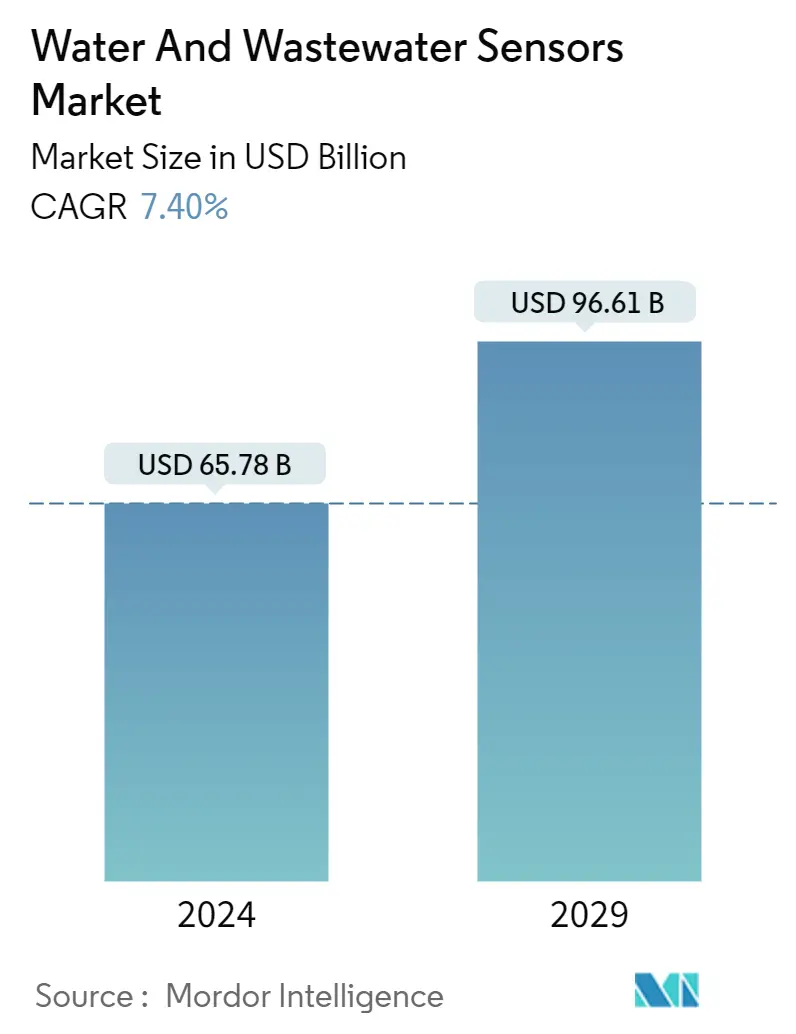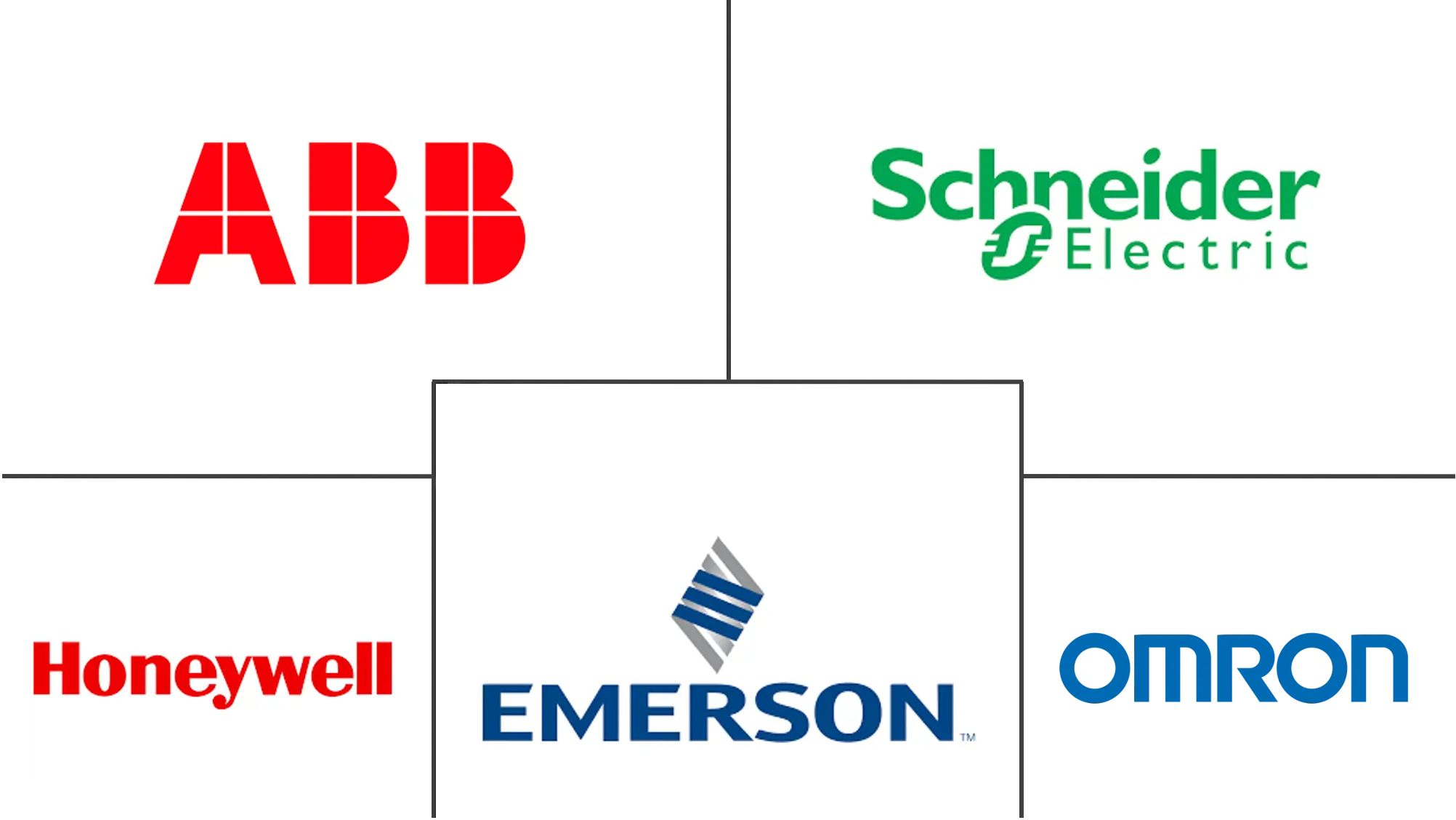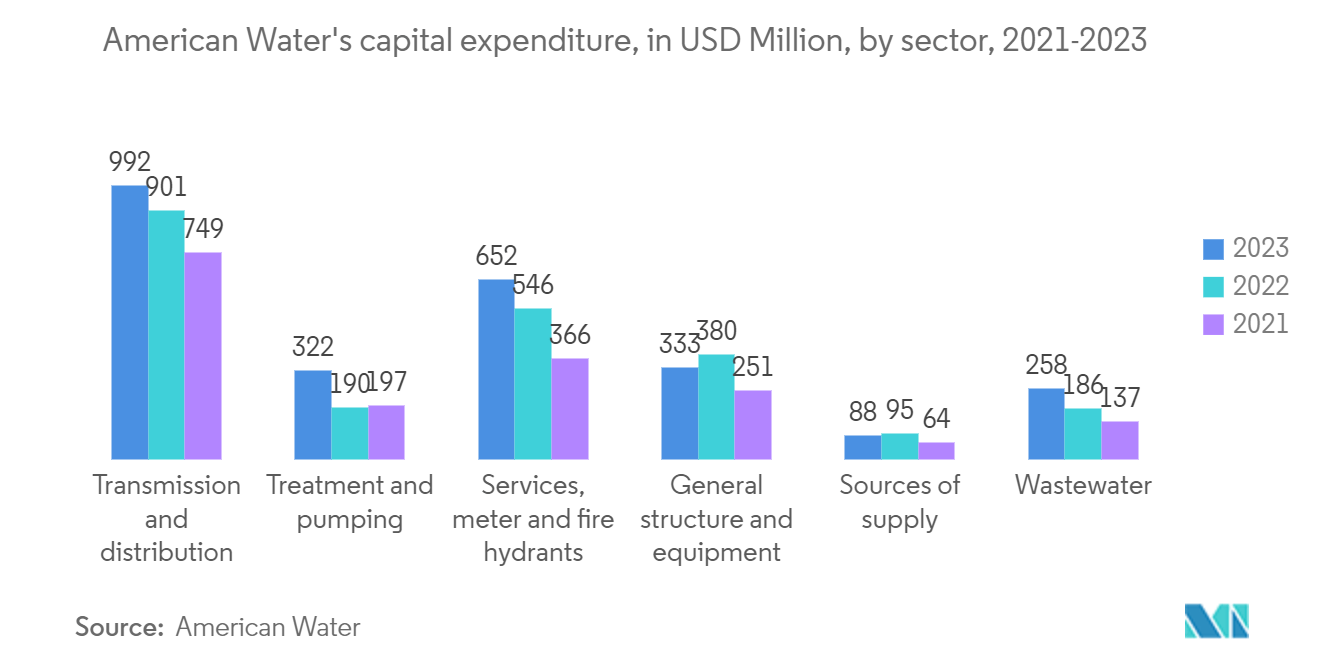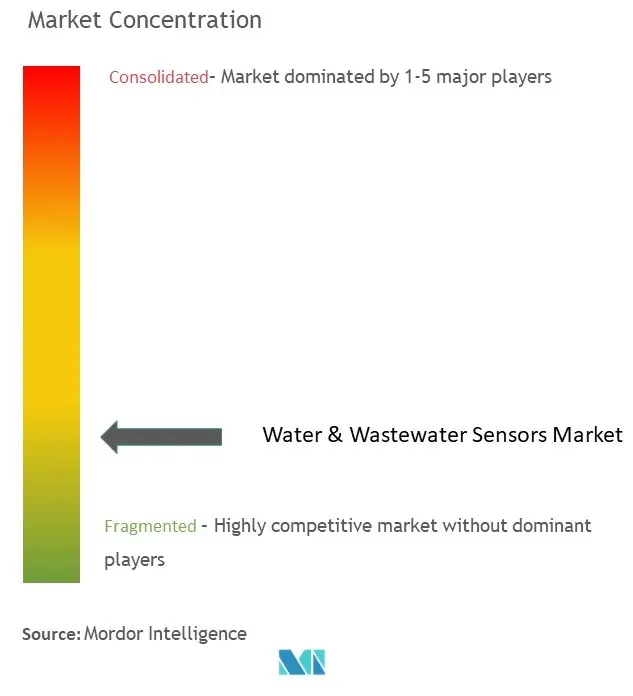Water and Wastewater Sensors Market Size

| Study Period | 2019 - 2029 |
| Market Size (2024) | USD 65.78 Billion |
| Market Size (2029) | USD 96.61 Billion |
| CAGR (2024 - 2029) | 7.40 % |
| Fastest Growing Market | Asia-Pacific |
| Largest Market | North America |
Major Players
*Disclaimer: Major Players sorted in no particular order |
Water and Wastewater Sensors Market Analysis
The Water And Wastewater Sensors Market size is estimated at USD 65.78 billion in 2024, and is expected to reach USD 96.61 billion by 2029, growing at a CAGR of 7.40% during the forecast period (2024-2029).
- Growing measurement of the rising level of water pollution and increasing government funding for controlling and monitoring pollution are key factors driving the market growth in the forecast period. Furthermore, the government of India is planning to invest INR 3.6 trillion (USD 50 billion) in the Jal Jeevan Mission, the government’s ambitious program to supply piped water to all households in the country, intent start in 2024.
- Increased demand for clean water due to industrialization, rising urbanization, and diminishing freshwater supplies are expected to enhance studied market demand. In August 2022, the US Department of Agriculture (USDA) announced a USD 75 million investment in critical infrastructure improvements to ensure thousands of rural people in Greenbrier County have clean drinking water and sanitary wastewater systems for years to come.
- Furthermore, according to the US Environmental Protection Agency, the Bipartisan Infrastructure Law delivers more than USD 50 billion to the Environmental Protection Agency (EPA) to improve the nation’s drinking water, wastewater, and stormwater infrastructure. Such investments in clean water projects may further drive the studied market demand.
- Moreover, in terms of changing or installing new pipelines, the rising number of infrastructure upgrades is expected to impact market growth positively. For instance, in November 2022, Southland Holdings, LLC announced that a subsidiary in its Civil segment, Oscar Renda Contracting, has been awarded a USD 59 million contract to construct a water pipeline project for the Eastern New Mexico Water Utility Authority.
- In addition, the United Nations Sustainable Development Goal 6 aims to ensure access to water and sanitation for all people across the globe by 2030. It is nudging governments to take steps in the right direction. Rising government initiatives to provide safe drinking water are anticipated to positively impact the growth of the water and wastewater sensors market in the forecast period.
- The high cost of water treatment plants led to limited penetration of water quality sensors in non-industrial applications may hinder the studied market growth in the forecast period. Additionally, a lack of awareness about water quality, especially in the rural areas of developing nations, is also hindering the development of the water and wastewater sensors market.
Water and Wastewater Sensors Market Trends
pH Sensor Expected to Witness Increased Demand
- pH sensor is one of the most usable sensors in water quality measurement. In terms of water treatment and purity, a pH sensor is crucial. These sensors determine how much acidity and alkalinity are present in water. It can guarantee safety, quality, and operations in a manufacturing or wastewater facility. In August 2022, a DIY pH meter using a pH sensor & Arduino with an OLED display. The company uses a pH sensor to determine how acidic or basic a water-based solution is.
- Further applications, such as chromium wastewater treatment and aquaculture, depend heavily on accurate pH measurements to ensure that required safety standards provide constant demand to the market.
- Moreover, government initiatives in water plants may create significant demand for pH sensors. According to American Water, for the fiscal year ending December 31, 2022, American Water incurred a capital expenditure of USD 2.3 billion. Based on that sum, USD 901 million was allocated to the transmission and distribution of funds. In addition, American Water spent USD 190 million on treatment and pumping that same year, which represented a slight decrease compared to the previous year. American Water, which operates in 14 states, is a publicly traded water and wastewater utility company.
- Furthermore, in April 2022, ANB Sensors launched breakthrough pH technology for water quality monitoring. The pH sensors, designed to “make pH easy,” are cost-effective, robust, and low maintenance. They provide accurate real-time monitoring, link with data platforms and networks, and integrate with multi-parameter units or stand-alone. Such innovations from vendors in the market may also drive the market growth.
- Globally, increasing water treatment plants and concerns regarding water scarcity are fueling the demand for pH sensors from the desalination sector. The pH of water gives important data for controlling the treatment system for desalination systems. Also, stringent government regulations on water contamination are expected to create significant demand for pH sensors in the sector.
- For instance, the US Environmental Protection Agency (USEPA) emphasizes improving water and sewage services, especially in the municipal wastewater treatment area. It plans to invest an estimated capital investment of about USD 600 billion toward its improvement over the coming two decades. Furthermore, the USEPA has also been focusing on supplying clean drinking water. It runs a fund called the ‘Clean Water State Revolving Fund,’ which finances environmental compliance. Such initiatives, in turn, increase the usage of water treatment plants, thereby creating demand in the studied market.

Asia Pacific to Experience Significant Market Growth
- The Asia-Pacific is one of the significant consumers of wastewater treatment equipment. Rising water-intensive gas exploration activities and substantial demand for industrial water reuse in the country are expected to enhance growth over the coming years.
- In June 2022, Evoqua Water Technologies LLC, a market leader in mission-critical water treatment systems, opened a new production plant in Singapore, marking the company's continued investment in Asia-Pacific, where there is a rising need for cutting-edge water treatment technologies.
- In the fiscal year 2021-2022, it is estimated that the total implementation cost of Swachh Bharat Mission-Urban 2.0 for its various components is INR 1,41,600 crores (USD 18.998 billion). The Government of India's share will be INR 36,465 crores (USD 4.892 billion), while the rest will be from other sources of funds, including CSR from the public/ private sector, external assistance, etc. It includes the fund allocation for water and wastewater treatment in the country.
- Further, north China has around 90% of the country's coal-based industries. Also, North China has rarer reserves of freshwater, thereby increasing the demand for wastewater technologies, which, in turn, provides opportunities for the wastewater treatment sensors market.
- Increasing water requirements from the industrial sector and changing government regulations to prevent water pollution and control action plans have increased the demand for water sensors in the region. Further, according to government statistics, water shortage in China's coastal areas is expected to reach 21.4 billion m3 over the next eight years. This water shortage for industrial and residential use is expected to increase the demand for water treatment sensors during the forecast period.
- Moreover, according to the Ministry of Jal Shakti of the Government of India, in FY 2022, the percentage of the rural population having access to safe and adequate drinking water within premises increased to 61.52% from 55.23% in FY 2021. Furthermore, the Indian government is targeting to provide 100% of its population with safe and adequate drinking water within premises by the year 2024 or 2025, which will boost the municipal water treatment plants in the country. Government initiatives in water and wastewater plants may further drive demand for water and wastewater sensors in the region.
- In addition, in October 2022, the Municipal Corporation of Greater Mumbai (MCGM), the utility agency responsible for municipal drinking water and sewerage in the city of Mumbai, awarded Suez a EUR 700 million (USD 745.53 million) contract for the design, construction, and operation (BOD) of a 500 MLD capacity treatment plant in Worli, Mumbai to serve an equivalent population of 2.5 million. This will strengthen the country's position in the international markets.

Water and Wastewater Sensors Industry Overview
The global water and wastewater sensors market presents a highly fragmented competitive landscape, marked by the presence of numerous market vendors worldwide. A commitment to innovative product development and industry expansion consistently drives market growth. Market participants perceive strategic partnerships and pioneering innovations as pivotal strategies for achieving maximum market penetration.
May 2024: Aqsen Innovations partnered with CENSIS, Scotland's leading innovation hub specializing in sensing, imaging, and IoT technologies, to further develop its sensor system, Aquasense. These IoT sensors offer real-time water quality monitoring, allowing data to be accessed remotely through mobile devices, thereby enhancing decision-making processes.
November 2023: IKEA launches three budget-friendly smart sensors – VALLHORN, PARASOLL, and BADRING – focused on water leakage and motion detection. These sensors empower customers with enhanced control and peace of mind, ensuring they remain connected to their homes, even in their absence.
Water and Wastewater Sensors Market Leaders
-
ABB Limited
-
Schneider Electric SE
-
Honeywell International Inc.
-
Emerson Electric Co.
-
Omron Corporation
*Disclaimer: Major Players sorted in no particular order

Water and Wastewater Sensors Market News
- January 2024: ABB acquired Real Tech, a Canadian firm renowned for its cutting-edge optical sensor technology that facilitates real-time water monitoring and testing. This acquisition not only bolsters ABB's already significant foothold in the water segment but also enriches its product lineup with essential optical technology, pivotal for advanced water management solutions.
- January 2024: Hydrific, a subsidiary of LIXIL, unveiled its inaugural product, Droplet. This advanced water usage sensor aims to revolutionize water conservation, making it both straightforward and intelligent. Positioned to monitor residential water consumption from a singular vantage point, Droplet delivers real-time analytics and insights. With this tool, homeowners, renters, and property managers can optimize water usage, cut down on utility expenses, and take preemptive measures against potential water damage.
Water and Wastewater Sensors Market Report - Table of Contents
1. INTRODUCTION
- 1.1 Study Assumptions and Market Definition
- 1.2 Scope of the Study
2. RESEARCH METHODOLOGY
3. EXECUTIVE SUMMARY
4. MARKET INSIGHTS
- 4.1 Market Overview
- 4.2 Industry Value Chain Analysis
-
4.3 Industry Attractiveness - Porter's Five Forces Analysis
- 4.3.1 Threat of New Entrants
- 4.3.2 Bargaining Power of Buyers
- 4.3.3 Bargaining Power of Suppliers
- 4.3.4 Threat of Substitute Products
- 4.3.5 Intensity of Competitive Rivalry
- 4.4 Technology Snapshot
- 4.5 Impacts of Macro trends on the Market
5. MARKET DYNAMICS
-
5.1 Market Drivers
- 5.1.1 Incremental Technological Advancements aiding the Market Growth
-
5.2 Market Restraints
- 5.2.1 Growing Complexity of Wearable Devices and Limited Use of Features, augmented With Security Risks
6. MARKET SEGMENTATION
-
6.1 By Type
- 6.1.1 pH Sensors
- 6.1.2 DO Sensors
- 6.1.3 Temperature Sensors
- 6.1.4 Turbidity Sensors
- 6.1.5 Other Types (ORP, Conductivity, etc.)
-
6.2 By Application
- 6.2.1 Municipalities
- 6.2.2 Industrial Wastewater Treatment
-
6.3 By Geography
- 6.3.1 North America
- 6.3.2 Europe
- 6.3.3 Asia
- 6.3.4 Australia and New Zealand
7. COMPETITIVE LANDSCAPE
-
7.1 Company Profiles
- 7.1.1 ABB Ltd
- 7.1.2 Schneider Electric SE
- 7.1.3 Honeywell International Inc.
- 7.1.4 Emerson Electric Co.
- 7.1.5 Omron Corporation
- 7.1.6 Swan Analytical Instruments
- 7.1.7 Gill Sensors and Controls
- 7.1.8 Aganoxa
- 7.1.9 Delta Phase Electronics Inc.
- 7.1.10 Yokogawa Electric Corporation
- *List Not Exhaustive
8. INVESTMENT ANALYSIS
9. FUTURE OF THE MARKET
** Subject To AvailablityWater and Wastewater Sensors Industry Segmentation
Different sensors, including pH, conductivity, ORP, turbidity, and dissolved oxygen, shall be used to maintain water quality. In industrial terms, it's known as an analyzer. According to which water is treated for waste or bad water, those analyzers form the main section of the water treatment plant.
The water and wastewater sensors market is segmented by type (pH sensors, DO sensors, temperature sensors, turbidity sensors, and other types), application (municipalities, industrial wastewater treatment, and other applications), and geography (Europe, North America, Latin America, Asia-Pacific, and Middle East and Africa)
The market sizes and forecasts are provided in terms of value in USD for all the above segments.
| By Type | pH Sensors |
| DO Sensors | |
| Temperature Sensors | |
| Turbidity Sensors | |
| Other Types (ORP, Conductivity, etc.) | |
| By Application | Municipalities |
| Industrial Wastewater Treatment | |
| By Geography | North America |
| Europe | |
| Asia | |
| Australia and New Zealand |
Water and Wastewater Sensors Market Research FAQs
How big is the Water And Wastewater Sensors Market?
The Water And Wastewater Sensors Market size is expected to reach USD 65.78 billion in 2024 and grow at a CAGR of 7.40% to reach USD 96.61 billion by 2029.
What is the current Water And Wastewater Sensors Market size?
In 2024, the Water And Wastewater Sensors Market size is expected to reach USD 65.78 billion.
Who are the key players in Water And Wastewater Sensors Market?
ABB Limited, Schneider Electric SE, Honeywell International Inc., Emerson Electric Co. and Omron Corporation are the major companies operating in the Water And Wastewater Sensors Market.
Which is the fastest growing region in Water And Wastewater Sensors Market?
Asia-Pacific is estimated to grow at the highest CAGR over the forecast period (2024-2029).
Which region has the biggest share in Water And Wastewater Sensors Market?
In 2024, the North America accounts for the largest market share in Water And Wastewater Sensors Market.
What years does this Water And Wastewater Sensors Market cover, and what was the market size in 2023?
In 2023, the Water And Wastewater Sensors Market size was estimated at USD 60.91 billion. The report covers the Water And Wastewater Sensors Market historical market size for years: 2019, 2020, 2021, 2022 and 2023. The report also forecasts the Water And Wastewater Sensors Market size for years: 2024, 2025, 2026, 2027, 2028 and 2029.
Water and Wastewater Sensors Industry Report
Statistics for the 2024 Water and Wastewater Sensors market share, size and revenue growth rate, created by Mordor Intelligence™ Industry Reports. Water and Wastewater Sensors analysis includes a market forecast outlook 2029 and historical overview. Get a sample of this industry analysis as a free report PDF download.



